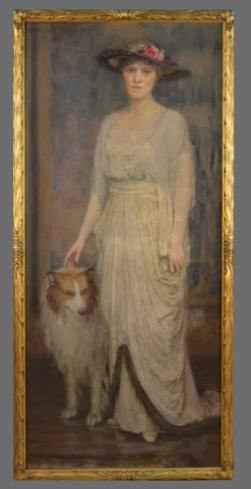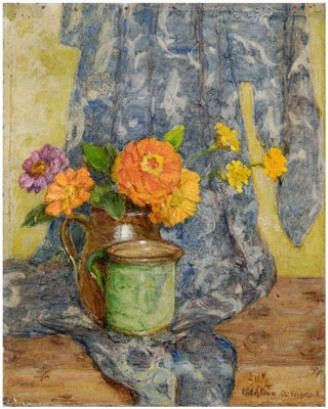 |
| Portrait of a Lady flanked by a Collie |
The Paintings of Adeline Albright Wigand
Adeline Albright Wigand (1852-1944) was an American painter. She was one of the first presidents of the National Association of Women Artists. She is known for her portrait paintings.
Wigand née Albright was born on June 24, 1852 in Madison, New Jersey. She was raised in Cedar Rapids, Iowa.[1] She studied at the Art Students League and Cooper Union Art School in New York. Her teachers in New York included William Merritt Chase.
Wigand traveled to Paris in the mid-1880s[1] where she studied at the Académie Julian. Her instructors included Tony Robert-Fleury and William-Adolphe Bouguereau.
Albright married fellow artist Otto Charles Wigand in 1890.
Wigand exhibited her work at the Palace of Fine Arts at the 1893 World's Columbian Exposition in Chicago, Illinois.[4] Wigand exhibited, and won prizes, at the National Academy of Design, the National Arts Club, and the National Association of Women Artists.[5] Additionally she exhibited at the Art Institute of Chicago, the Corcoran Gallery of Art, and the Paris Salon.
Wigand's listing in Woman's Who's Who of America: A Biographical Dictionary of Contemporary Women of the United States and Canada, 1914-1915 noted that she "Favors woman suffrage". Wigand was a member of the National Association of Women Artists, serving as one of its first presidents. She also served as the head of the Art Committee of the Staten Island Institute of Arts and Sciences from 1925 to 1931.
Wigand died on March 31, 1944.
Wikipedia

 |
| Polly |
Polly highlights Adeline's gift for painting animals, which can also be glimpsed in the bear head in the rug in Portrait of a Young Girl. Polly was a beloved family pet in the Wigand household. There is some evidence that the gilt mirror in this picture was of special significance to the artist, as it is probably the mirror mentioned in her will along with several other pieces of antique furniture.
The picture is something of a visual puzzle. The viewer of the painting is placed in the position where he or she would naturally see his or her reflection, only to be replaced by a female figure (probably the artist) whose features are less distinct and animated than the bird on the table in front of her. A number of the women portrayed in Adeline's pictures from the early decades of the 20th century are infused with subtle tension and obscured features, and despite the bright colors and highly decorative aspects of Polly, the artist makes a subtle analogy between the gilded cage of the bird and the woman caught within the borders of the gilt mirror frame.
 |
| Portrait of Otto Wigard, 1895 |
Adeline's handsome portrait of her husband is a tribute to her affection for him. Otto appears as a thinking, gentle person with a poetic air. Notably, Adeline does not portray Otto in the guise of a fellow artist -- there are no palettes or easels to signal his successful, considerable output in an array of artistic media. Instead this is a domestic but atmospheric work. The art on the wall behind Otto remains indistinct, and it is unclear if it is one of Otto's or Adeline's own creations.
Although she has reversed the composition, Adeline's use of a restricted color palette was likely inspired by Whistler's Portrait of Thomas Carlyle. However, the atmosphere conveyed is different from the Whistler inspiration. Adeline has softened Otto's gaze, and something of Otto's creative nature appears in his look, as if he is a bit of a dreamer, gazing off into the distance, whereas Carlyle appears alert and bolt upright with anticipation.
 |
| Woman Reading a Letter, 1910 |
Woman Reading a Letter is a far cry from the staid and sentimental portraits of children that Adeline executed with technical ease. The daring atmosphere of this work, illuminated by shaded candlelight, has many historic precedents, dating back to the works of Caravaggio and George de la Tour and the British artist Joseph Wright of Derby, famous for his candlelit subjects, as well as lamplit scenes like Edgar Degas' Interior. Adeline's daring use of blue flesh tones conveys a chilly interior and associations with death, at odds with the portrayal of beauty. Erotic and mysterious, the faded flowers on the table suggest some disappointment in the missive she is reading, perhaps the aftershock of some disturbing event. Adeline clearly realized that this work was a breakthrough for her: the painting won the National Arts Club Prize of $100 in 1912, and it appeared at the Art Institute of Chicago, the Corcoran Gallery of Art, the City Art Museum.

Still Life with Zinnias in a Pitcher with Green Cup and Blue Drape
CURIATOR

No comments:
Post a Comment